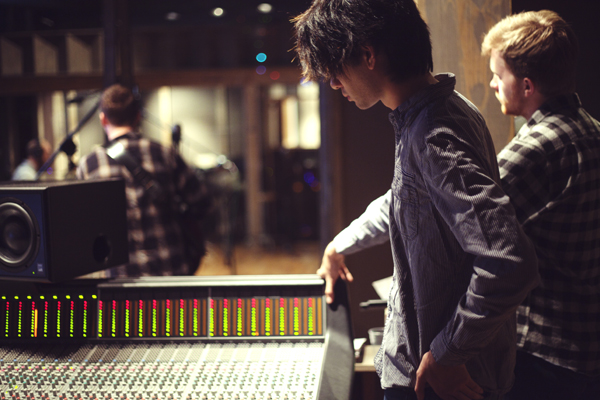Buzzworthy
Get More:
Stone Cold Fox, Seventeen, Music, More Music Videos
PRE-PRODUCTION
What was your pre-production like on this project?
Ariel: The pre-production process involved us recording a demo and bringing it to our producer Joel Hamilton for opinion and critique. With his insight and direction, we would go back to our home studio and rework out parts and arrangements on the demo. This went back and forth a couple of times before we hit the studio.
How did you choose the studio?
Ariel: The summer after my junior year in college (2011), I was in search of an internship with Studio G (now referred to as Studio G Classic). Instead of finding myself in the studio, I was recruited to help construction of their new space: Studio G 5000. I spent a summer helping to turn a 5,000 square foot warehouse into a state-of-the-art recording complex, consisting of three studio rooms, so it only made sense that we went back to record there.

PRODUCTION
What kind of sound were you looking for and how did you achieve it?
Kevin: We were looking for a rockier sound. The instruments were more rhythm-driven and we used the vocals to carry the primary melody. We also decided to only use live drums instead of incorporating programmed drums.
How does it compare to your last release in terms of style and the creative process?
Kevin: It’s angrier. It’s not like the EP songs, which are about home and growing up. It comes from a much more visceral, emotional place of breakup and withdrawal. It’s like the difference between walking down a hill and jumping off a cliff. Let’s just say it was a difficult time [laughs].
Did you use any special gear or recording techniques on this one?
Ariel: Yes, yes, and yes. Joel [Hamilton, producer] has a command-station’s worth of “special gear” and is an audio wizard of sorts. One of the notable chains was running guitar with an EarthQuaker Devices Organizer [Polyphonic Organ Emulator] pedal into an Echoplex [tape delay].
What was your philosophy on live, full-band takes versus individual tracking?
Ariel: We always like to individually track for recording purposes, but we have everyone playing together for the performance and feel.
What did you try to accomplish in the studio that you’re not able to do live?
Kevin: We really concentrated on finding the exact sounds we wanted to represent the song. We wanted to experiment in certain parts, as well, and we really needed to sit down and observe it, rather than playing it live. The live version is like a caricature of sounds; we have our pedals and tones that give the general idea of the sounds we want, but it wasn’t until we sat down and observed each sound that we really discovered what the song needed.
What were the toughest challenges you faced?
Ariel: In regards to recording, it was one of the smoothest and most enjoyable recording processes I have ever been a part of. We did have conflicted feelings in the songwriting and arrangement in a section of the song during preproduction, which ended up being resolved on the first day in the studio. Also being the producer and engineer for everything up to this point, it was a challenge to consciously relinquish some control and entrust to the producer.
Kevin: I’m really used to working with Ariel as the producer, and we’ve developed a certain routine of yelling at each other in disagreement for days. We really come from different places so it takes us a while to lock down the final say, but it usually comes out balanced and we both end up happy. It was definitely different working with Joel because I had slightly less control. We really just had to put our trust in Joel to find the right take, the right sound, and the right mix for the song. Though it was a jarring experience, the song came out amazing and working with Joel proved to be extremely educational and frankly inspirational.
Any funny stories from the sessions that you’ll be telling for a while?
Kevin: On one of the more experimental sections of the song, we had an ongoing joke about finding “just the right amount of heroin.”
POST-PRODUCTION
How did you handle final mixing and mastering?
Ariel: We spent two days in the studio and Joel was able to give us a final mix by the end of our second day.
What are your release plans?
Kevin: We are releasing the single along with a music video, which I will be directing, in early February – right in time for the Valentine’s Day. So we can all be depressed and pissed off together!
ALBUM INFO:
Stone Cold Fox
Seventeen (single)
Recording Studio: Studio G 5000, Brooklyn NY
Label: Self-Released
Release Date: February 2013
Produced, Engineered & Mixed by Joel Hamilton
Assisted by Francisco Botero and Michael Jinno
KEY GEAR:
· Custom Thinline Telecaster
· 1972 Rickenbacker 4001 Bass
· Epiphone Casino
· Fender Silverface Twin Reverb
· Supro Model 24
· Korg Delta
· Eurorack Modular Synth
· Echoplex Tape Delay
· Coles 4038 Ribbon Microphone
· Soundelux U95 Multi-Pattern Tube Condenser Microphone
For more visit www.stonecoldfoxmusic.com.
Have a unique studio story to share? Email editorial@performermag.com.
photos by Jen Painter